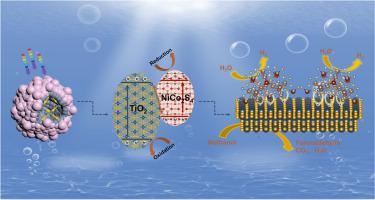当前位置:
X-MOL 学术
›
J. Mater. Sci. Technol.
›
论文详情
Our official English website, www.x-mol.net, welcomes your feedback! (Note: you will need to create a separate account there.)
A hollow core-shell TiO2/NiCo2S4 Z-Scheme heterojunction photocatalyst for efficient hydrogen evolution
Journal of Materials Science & Technology ( IF 11.2 ) Pub Date : 2024-06-28 , DOI: 10.1016/j.jmst.2024.06.016 Mao-Jin Ran , Meng Wang , Zhi-Yi Hu , Yi-Fu Huang , Lin-Dong Wang , Lu Wu , Man-Man Yuan , Jian Zhang , Bei Li , Gustaaf Van Tendeloo , Yu Li , Bao-Lian Su
Journal of Materials Science & Technology ( IF 11.2 ) Pub Date : 2024-06-28 , DOI: 10.1016/j.jmst.2024.06.016 Mao-Jin Ran , Meng Wang , Zhi-Yi Hu , Yi-Fu Huang , Lin-Dong Wang , Lu Wu , Man-Man Yuan , Jian Zhang , Bei Li , Gustaaf Van Tendeloo , Yu Li , Bao-Lian Su

|
Constructing heterojunctions have received significant attention in photocatalysis because of their efficient separation of photogenerated carriers and improving light utilization efficiency. Bimetallic sulfides (e.g. NiCoS) are applied in electrocatalysis and supercapacitors that can be coupled with TiO to form a heterojunction. Owing to the staggered energy band arrangement between TiO and NiCoS, the establishing of a Z-scheme heterojunction between them is expected to enhance the carrier separation efficiency and reduce the sulfide photo-corrosion. However, the application of NiCoS in photocatalysis and studies on the mechanism of the TiO/NiCoS Z-scheme heterojunction have seldom been reported. In this work, we obtained a hollow core-shell TiO/NiCoS Z-scheme photocatalyst through a solvothermal method for photocatalytic hydrogen evolution (PHE). The PHE rate of the optimized TiO/NiCoS-0.3 is 8.55 mmol g h, approximately 34 times higher than pure TiO, 94 times higher than pure NiCoS. The remarkable photocatalytic activity can be ascribed to the hollow structure and the in-situ constructed Z-scheme heterojunction. The photogenerated charge transfer mechanism is revealed by hydroxyl radical trapping experiments and electron paramagnetic resonance (EPR) characterization. The in-situ construction of the Z-scheme heterojunction not only enhances the efficiency of separating the photogenerated carriers but also reduces the photo-corrosion of NiCoS. This study proposes an effective strategy for the design of TiO-based Z-scheme heterojunctions and the application of NiCoS in photocatalysis.
中文翻译:

用于高效析氢的空心核壳 TiO2/NiCo2S4 Z 型异质结光催化剂
构建异质结因其有效分离光生载流子并提高光利用效率而在光催化领域受到广泛关注。双金属硫化物(例如 NiCoS)应用于电催化和超级电容器,可以与 TiO2 耦合形成异质结。由于TiO和NiCoS之间的交错能带排列,在它们之间建立Z型异质结有望提高载流子分离效率并减少硫化物光腐蚀。然而,NiCoS在光催化中的应用以及TiO/NiCoS Z型异质结机理的研究却鲜有报道。在这项工作中,我们通过溶剂热法获得了一种空心核壳TiO/NiCoS Z型光催化剂,用于光催化析氢(PHE)。优化后的TiO/NiCoS-0.3的PHE率为8.55 mmol g·h,比纯TiO高约34倍,比纯NiCoS高约94倍。显着的光催化活性可归因于中空结构和原位构建的Z型异质结。通过羟基自由基捕获实验和电子顺磁共振(EPR)表征揭示了光生电荷转移机制。 Z型异质结的原位构建不仅提高了光生载流子的分离效率,而且减少了NiCoS的光腐蚀。本研究为 TiO 基 Z 型异质结的设计和 NiCoS 在光催化中的应用提出了一种有效的策略。
更新日期:2024-06-28
中文翻译:

用于高效析氢的空心核壳 TiO2/NiCo2S4 Z 型异质结光催化剂
构建异质结因其有效分离光生载流子并提高光利用效率而在光催化领域受到广泛关注。双金属硫化物(例如 NiCoS)应用于电催化和超级电容器,可以与 TiO2 耦合形成异质结。由于TiO和NiCoS之间的交错能带排列,在它们之间建立Z型异质结有望提高载流子分离效率并减少硫化物光腐蚀。然而,NiCoS在光催化中的应用以及TiO/NiCoS Z型异质结机理的研究却鲜有报道。在这项工作中,我们通过溶剂热法获得了一种空心核壳TiO/NiCoS Z型光催化剂,用于光催化析氢(PHE)。优化后的TiO/NiCoS-0.3的PHE率为8.55 mmol g·h,比纯TiO高约34倍,比纯NiCoS高约94倍。显着的光催化活性可归因于中空结构和原位构建的Z型异质结。通过羟基自由基捕获实验和电子顺磁共振(EPR)表征揭示了光生电荷转移机制。 Z型异质结的原位构建不仅提高了光生载流子的分离效率,而且减少了NiCoS的光腐蚀。本研究为 TiO 基 Z 型异质结的设计和 NiCoS 在光催化中的应用提出了一种有效的策略。
















































 京公网安备 11010802027423号
京公网安备 11010802027423号